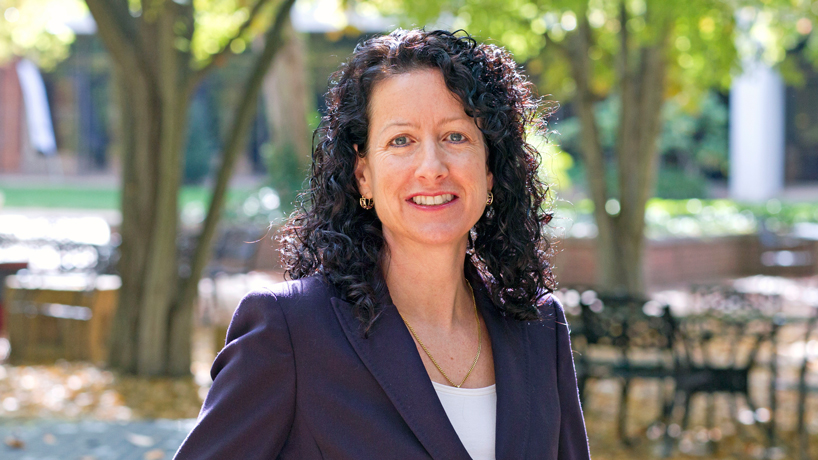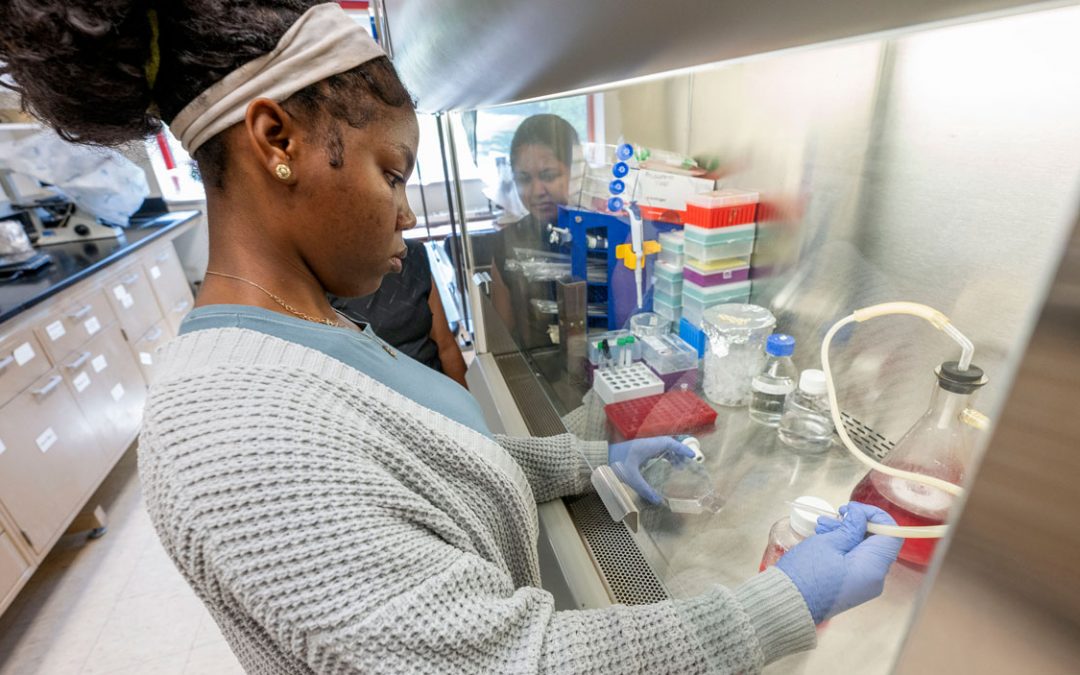
Mary Lacity, Curators’ Distinguished Professor of Information Systems at UMSL, is investigating how organizations are preparing for blockchains. (Photo by August Jennewein)
If you go a day without hearing about the evolving nature of blockchains, you’re probably missing something.
Just this week, there have been stories on the ways health-care execs, human-resources professionals and even legal marijuana distributors can all utilize these systems. But does the hype around blockchains align with their applications?
UMSL Daily asked this question and many more of Mary Lacity, Curators’ Distinguished Professor of Information Systems at the University of Missouri–St. Louis. Lacity, who is investigating blockchains at the Massachusetts Institute of Technology as a visiting scholar, debunks misconceptions about the technology and reveals what organizational leaders as well as consumers need to know about its capabilities.
To start, can you give us an overview of what blockchain technology is and its potential?
First, I’ll give you a definition. A blockchain is a decentralized, peer-to-peer system for validating, time-stamping and permanently storing transactions and agreements on a shared distributed ledger. You might be thinking, “Huh? Come again?” So let’s forget the definition for a minute and focus on what it enables. A blockchain is actually a set of technologies that allow people to transact directly with each other without needing third-party intermediaries. Instead of relying on institutions to facilitate transactions, blockchains rely on computer algorithms.
Let’s start with Bitcoin because most people are familiar with it. Bitcoin gets all the attention because it’s been successfully running since 2009 and because of its skyrocketing price. What’s most intriguing about Bitcoin is that it proves that an anonymous crowd can securely maintain a completely decentralized application – no one entity owns it or controls it. Bitcoin is just one type of blockchain application. It’s a payment system, but the same underlying technology has thousands of potential use cases. Blockchains are thus a completely new form of software that enables new forms of organization. That’s why it’s so exciting to study.
What are the advantages of blockchains?
All innovations represent some advantage relative to the status quo. So first we have to understand centralized applications and the role they play in commerce. When individuals or organizations want to trade in today’s world, we engage trusted third parties like banks or credit card companies to facilitate transactions. Each party to the transaction – the trading partners and the trusted third parties upon which they rely – maintain their own centralized systems that do not talk to each other. Consequently, trading partners spend a lot of time and money reconciling and settling transactions to make sure records agree. These centralized systems are also vulnerable to attack. Think about Equifax, Target, Sony, JPMorgan, Netflix … the list goes on.
Decentralized systems like blockchains promise to overcome many of these limitations. With one decentralized system, there is one version of the truth, thus no reconciliations, enabling fast settlement times and lower transaction costs. Furthermore, decentralized systems are more secure. All of the copies of the records constantly chatter with each other to maintain agreement. The only way to break a blockchain is to commandeer more than 50 percent of the copies before any of the other copies notice. Thus, decentralized applications promise heightened security. There’s a lot of potential benefits.
What are some of the most widespread misunderstandings of blockchains?
There are many misunderstandings. Why? Because the underlying technology is difficult to grasp for non-technical people. I’m an IT professor, and it took me months to understand what the components – like distributed ledgers, consensus protocols, native digital assets, cryptography and smart contracts – are doing and what they enable.
First, many people equate Bitcoin with blockchains. Again, Bitcoin is just one example of a blockchain used for a very narrowly defined application: payments. Even if the Bitcoin bubble bursts, other viable use cases already exist and many new ones will emerge.
Second, many people think decentralized applications like Bitcoin will only be used for nefarious purposes like money laundering, illegal trading or tax avoidance. I cannot disagree more. Just like the internet enables both ethical and unethical uses, so do blockchain technologies.
Third, many people think blockchains are hacked a lot, but they are not. The newsworthy hacks are nearly always on the centralized applications that connect us to a decentralized blockchain. The public key is stored on the blockchain to record the transaction, but the private key that proves you own the asset is stored off the blockchain, typically in the exchange where you bought it. Cyber thieves want those private keys, so you have to be very careful where you choose to store them. Ironically, the safest place is on paper that you store in a physical vault.
A variety of industries – government, banking, health care – are all considering this technology. Can its application truly be this wide?
Step back in time to 1992, and you saw the internet for the first time. What could organizations do with it? No one could have anticipated how the internet would change the economic, social and political fabric of our world. Jump ahead to 2017. The use cases for shared, decentralized systems like blockchains are limitless. Whether you are a libertarian who wants to use blockchains to get rid of government control, a philanthropist who wants to bring cheap financial services to the 2 billion people who do not have access to credit, an entrepreneur who wants to create new businesses using these technologies or a traditional company who wants to improve existing products and services, decentralized systems are a promising idea. All those parties can identify legitimate use cases.
How are blockchains already changing the way we share data and perform transactions?
Blockchains are still an immature technology. The blockchains that are currently deployed and operating well are still primarily payment systems like Bitcoin, Ripple and Stellar. Ethereum is another successful blockchain that is more than just a payment system. It allows people to build other use cases on top of the blockchain by using what is known as a “smart contract,” a programmable agreement that parties can deploy and store on the Ethereum blockchain. But there are billions invested in startup companies and many large institutions are working with open-source communities to architect the future.
What are steps business leaders can take today to engage in blockchain technology?
I’m a visiting scholar at MIT this year. I am in charge of a project that is investigating how organizations are preparing for blockchains. Our message is this: Every organization needs to understand decentralized systems like blockchains. Businesses can either be victimized by the future or help architect the future.
Why should the average consumer care about these systems?
For consumers, the most promising part of decentralized systems like blockchains is the ability to own and control your own identity, your own data and your own creative works. Today, we let institutions collect, store and own data about us, and often give them our information for free. In the future, consumers will very likely control and own their health-care data, financial data, certification data or your own creative works and intellectual property. Institutions could very well pay us for the privilege of accessing our data and licensing our creative works.
If students want to learn more, the College of Business Administration hosts a blockchain meetup group once a month. Graduate business majors are also learning about blockchains in our core IS class. So far I’ve taught blockchains to over 100 graduate students.
UMSL’s next blockchain learning session is scheduled for 7 p.m. Wednesday in Room 103 of Express Scripts Hall. The networking and discussion event will focus on Ethereum.














